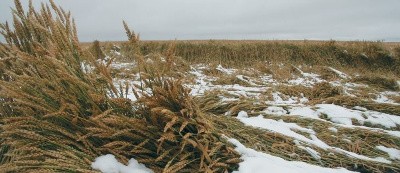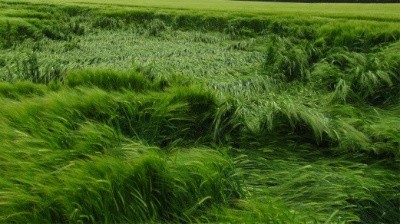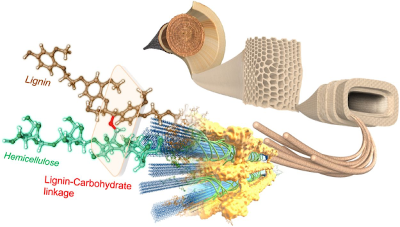Don’t Get Caught with Your Plants Down: The Solution for Crop Lodging
Lodging occurs when the crop falls over and does not return to a standing position. Crop lodging can be very costly to producers and can pose many challenges during harvest. For instance, it is common to see secondary growth on the flattened crop extending maturity and diminishing grain quality.
 For the past couple of years, harvest in some parts of the Prairies has been interrupted by heavy snow fall, leaving millions of acres for producers to deal with in the spring. If you’re a grower who has been in this situation, you know that a lodged crop can take twice as many resources to harvest than a standing one.
For the past couple of years, harvest in some parts of the Prairies has been interrupted by heavy snow fall, leaving millions of acres for producers to deal with in the spring. If you’re a grower who has been in this situation, you know that a lodged crop can take twice as many resources to harvest than a standing one.
Not only is it a challenge to take off the field, a lodged crop can have a significant reduction in value. If the crop lodges at ear emergence, yields can be reduced by up to 75 per cent. Although later lodging has less effect on yield, it can impact grain quality, harvest speeds and drying costs.
Continue reading to learn more about crop lodging and what can be done to avoid it, so you are not caught with your plants down.
Root Lodging and Stem Failure
 Two types of lodging can be differentiated: root lodging and stem failure. To a degree, most commonly used varieties are susceptible to root lodging, stem failure or both.
Two types of lodging can be differentiated: root lodging and stem failure. To a degree, most commonly used varieties are susceptible to root lodging, stem failure or both.
Root lodging occurs early in the season as a result of a poor root development, which could be caused by a manganese deficiency, and/or disease, such as take-all. Stem failure, on the other hand, happens later in the season as a result of stem breakage or collapse under the weight of the maturing heads. Lignin content and quality also play an important role, as failure occurs at the weakest point when there is heavy rain or strong winds
Factors Contributing to Lodging
When the gravity pulling the crop down to the ground is greater than the counter forces keeping it standing, lodging occurs.
Effective prevention of crop lodging requires first knowing its underlying cause, as many factors can contribute to crop lodging. Here are some common ones:
- Excessive Nitrogen: The most common cause is the excessive use of nitrogen, often combined with a heavy seeding rate or the use of tall varieties. Heavy application of nitrogen prior to seeding or before the start of stem elongation often produces weaker stems with longer internodes.
- Insufficient Root Development: When the growing conditions don’t allow for sufficient development of crown roots, crop anchorage remains shallow, exposing the crop to lodging especially under heavy rains or strong winds.
- Heavy Rain or Irrigation: Heavy rain or irrigation can damage the top 2” of the soil and increase the risk of root lodging. In addition, irrigated crops stay in the ground for longer, increasing the possibility of wind damage prior to harvest.
- Take-all: Take-all disease can spread rapidly in the field when crop rotation is tight, weakening the plants and making them vulnerable to lodging
Other indirect causes include growing the crop on heavily-manured land with poor potassium and/or manganese levels.
With an understanding of these contributing factors, a grower can choose the right crop variety for their local conditions. For instance, a poor rooting variety cannot be chosen for late seeding, nor seeded at a heavy rate, especially when the field is lacking manganese or potassium. Similarly, taller varieties should not be sown early, as earlier seeding makes the crop grow taller and produce more tillers with longer, thinner and weaker stems.
OMEX Has the Solution

Options for preventing or reducing crop lodging center on improving root growth and development in the early stages of the crop, combined with the encouragement of lateral growth and/or the reduction of crop height, and increasing lignin content to strengthen the stems.
To help develop a strong root system, able to absorb water and nutrients as well as anchor the crop into the soil, I recommend starting the season with an OMEX Primer, especially Primer Mn. Primer Mn allows the seedlings to early access phosphorus, potassium, zinc and manganese for healthy roots and promotion of lateral growth prior to the 3-5 leaf stage.
The use of Plant Growth Regulators (PGRs) to control the height of the crop will minimize the chances of falling over, and the addition of key micronutrients at critical stages – flag leaf and prior to stem elongation – will trigger lignin synthesis and accumulation in the stems, allowing them to remain sturdy and able to withstand heavy rain and/or strong winds.
Talk to your OMEX Representative or ag retailer about strategies to help keep your plants up! Your rep can provide information about the OMEX products that can prevent lodging in your crop, along with great crop nutrition advice.
